Between 7 a.m. and 3 p.m., a total of 50 trucks drove between Sloterdijk and the construction site, located between the metro station and the rail platforms of Amsterdam Zuid station. Some intricate planning was done in advance regarding how and when the trucks would drop off their load, to make sure the trucks would not be held up. But at least the team already knew that the fully laden trucks would make it up the slope from Parnassusweg, because they had already done that when they were pouting the second roof section. So the mood was positive, no stress. Nevertheless, creating this section – the third of seven roof sections needed for the second pedestrian underpass (the Brittenpassage) – is still an important milestone for the builders. ‘Creating the formwork for this roof section was more difficult and took longer than the previous one, but everything is coming together today. The new roof section is getting bigger by the hour’, explains foreman Frank van Klaren.
Precision pouring
It is quite a sight, watching this enormous formwork mould slowly fill up with the concrete being pumped in by two pumps. It’s like watching an enormous bathtub being filled. But the team doesn’t have time to stand around watching the level of the concrete slowly rise. ‘If only we did, it’s such lovely weather’, laughs Van Klaren. They have to keep a close eye on everything. ‘Pouring concrete isn’t rocket science, but once it has set, that’s it, there’s no going back. So we have to make sure the process is happening in a calm and controlled way, especially towards the end. The dimensions of the roof section – 70 metres by 6 metres – need to be exactly right. If we pour too much concrete, this section won’t match up with the other roof sections properly.’

Quite a spectacle
The first roof section for the Brittenpassage was put into place in November 2019 and that was quite a spectacle. ‘It was definitely a very special moment’, recalls Van Klaren. ‘It was a gigantic section of course, measuring 70 metres long, 12 metres wide and 2 metres thick. Manoeuvring it into place accurately was no easy task. We also had to close the railway line and the A10.’ After that, the construction of the next two roof sections began, and they will be put into place between 20 to 23 August 2021. The A10 will not need to be closed for that, but metro and train services will operate to a modified timetable. The foundations on which these two sections will rest were completed at Easter.

Even stronger
Today’s pouring work doesn’t mean the team’s job is over. ‘Once we’ve finished the concrete for the roof section and it has hardened sufficiently, we need to tighten the eight prestressing ducts that are inside the concrete roof section’, explains van Klaren. ‘We will need to do that twice. At the end of this week we’ll tighten up the cables to 10 percent, and after a few weeks they’ll be up to full tension.’ Together with 100 tons of reinforcing steel bars, these ducts will ensure that the roof section can withstand even more weight. ‘That’s vital, because the seven roof sections will not only form the roof over the pedestrian walkway, but will also carry the trains and metros above. So they need to be able to support their enormous weight and meet many requirements.’ And that is why they are called prestressing ducts: ‘We tighten them up before they have to support any heavy loads.’

Layer cake
Once the prestressing ducts have been tightened, the builders will apply a waterproof layer to the concrete, and ballast mats and a drainage system will be installed. ‘It’s like a huge layer cake’, van Klaren laughs. ‘Except it needs to last 100 years and it takes a lot of skill and expertise to get everything just right.’ Meantime, the concrete is slowly rising to the right level and the final shape of the roof section is becoming clearer. It is still difficult to imagine that many thousands of passengers will one day be walking under this concrete roof section. ‘I often have to explain to people why the project can’t be finished any quicker’, says Van Klaren. ‘But when I explain that public transport needs to keep running the whole time, and we can’t simply close the A10 for a long time, they start to get it. We’re working in a very confined space and also trying to minimize the disruption. All of that has an impact on the planning, of course.’ But the new pedestrian underpass will be ready in 2025.

Give your opinion